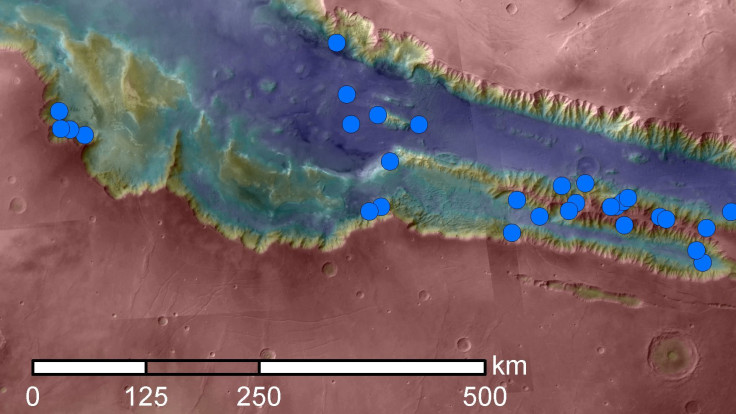Is There Water On Mars? Not Much, Says NASA Analysis

Last September, scientists from University of Arizona uncovered dark streaks while perusing images of Mars from NASA’s Mars Reconnaissance Orbiter. These streaks—called recurrent slope linae or RSLs—were spotted on the planet’s surface and the darkness hinted at the possibility that the RSLs contain large quantities of water. The was a significant finding, as astronomers speculated that the dark streaks contained water inside of them. Should this be true, it would be the first sign suggesting the planet could sustain life.
Now, after a new analysis, scientists have found that the RSLs do not contain as much water as previously anticipated. By using the Mars Odyssey's Thermal Emission Imaging System (THEMIS), NASA scientists were able to measure, remotely from orbit, the surface temperature of the walls of craters within the Valles Marineris canyon.
“When water is present in the spaces between particles of soil or grains of sand, it affects how quickly a patch of ground heats up during the day and cools off at night," said NASA officials, who published their findings online in the journal Geophysical Research Letters , in a statement .
Analyzing years of temperature data from the ground revealed to the scientists that the amount of liquid surface water on Mars is less than the amount of water found on Earth’s driest deserts. Specifically, a high-end estimate of water content in the soil on the planet is 3 percent, which is similar to that of the Atacama Desert in Chile, which is the driest non-polar desert on the planet.
"We used a very sensitive technique to quantify the amount of water associated with these features," said Christopher Edwards of Northern Arizona University, Flagstaff, in a statement. "The results are consistent with no moisture at all and set an upper limit at three percent water."
Last year, the team revealed that the dark streaks have “hydrated salts,” which was confirmed in the new study.
"Our findings are consistent with the presence of hydrated salts, because you can have hydrated salt without having enough for the water to start filling pore spaces between particles," Christopher Edwards, a faculty member in the Department of Physics and Astronomy at Northern Arizona University, told Space . "Salts can become hydrated by pulling water vapor from the atmosphere, with no need for an underground source of the water."
For the time being, the scientists believe water activity exists in the RSL but not to the magnitude previously believed.
"Some type of water-related activity at the uphill end still might be a factor in triggering RSL, but the darkness of the ground is not associated with large amounts of water, either liquid or frozen," Edwards said. "Totally dry mechanisms for explaining RSL should not be ruled out."
© Copyright IBTimes 2024. All rights reserved.






















